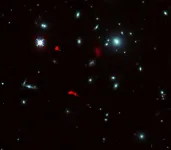(Press-News.org) Using the Atacama Large Millimeter/submillimeter Array (ALMA), astronomers found a rotating baby galaxy 1/100th the size of the Milky Way at a time when the Universe was only seven percent of its present age. Thanks to assistance by the gravitational lens effect, the team was able to explore for the first time the nature of small and dark "normal galaxies" in the early Universe, representative of the main population of the first galaxies, which greatly advances our understanding of the initial phase of galaxy evolution.
"Many of the galaxies that existed in the early Universe were so small that their brightness is well below the limit of the current largest telescopes on Earth and in Space, making difficult to study their properties and internal structure," says Nicolas Laporte, a Kavli Senior Fellow at the University of Cambridge. "However, the light coming from the galaxy named RXCJ0600-z6, was highly magnified by gravitational lensing, making it an ideal target for studying the properties and structure of a typical baby galaxies."
Gravitational lensing is a natural phenomenon in which light emitted from a distant object is bent by the gravity of a massive body such as a galaxy or a galaxy cluster located in the foreground. The name "gravitational lensing" is derived from the fact that the gravity of the massive object acts like a lens. When we look through a gravitational lens, the light of distant objects is intensified and their shapes are stretched. In other words, it is a "natural telescope" floating in space.
The ALMA Lensing Cluster Survey (ALCS) team used ALMA to search for a large number of galaxies in the early Universe that are enlarged by gravitational lensing. Combining the power of ALMA, with the help of the natural telescopes, the researchers are able to uncover and study fainter galaxies.
Why is it crucial to explore the faintest galaxies in the early Universe? Theory and simulations predict that the majority of galaxies formed few hundred millions years after the Big-Bang are small, and thus faint. Although several galaxies in the early Universe have been previously observed, those studied were limited to the most massive objects, and therefore the less representative galaxies, in the early Universe, because of telescopes capabilities. The only way to understand the standard formation of the first galaxies, and obtain a complete picture of galaxy formation, is to focus on the fainter and more numerous galaxies.
The ALCS team performed a large-scale observation program that took 95 hours, which is a very long time for ALMA observations, to observe the central regions of 33 galaxy clusters that could cause gravitational lensing. One of these clusters, called RXCJ0600-2007, is located in the direction of the constellation of Lepus, and has a mass 1000 trillion times that of the Sun. The team discovered a single distant galaxy that is being affected by the gravitational lens created by this natural telescope. ALMA detected the light from carbon ions and stardust in the galaxy and, together with data taken with the Gemini telescope, determined that the galaxy is seen as it was about 900 million years after the Big Bang (12.9 billion years ago). Further analysis of these data suggested that a part of this source is seen 160 times brighter than it is intrinsically.
By precisely measuring the mass distribution of the cluster of galaxies, it is possible to "undo" the gravitational lensing effect and restore the original appearance of the magnified object. By combining data from Hubble Space Telescope and the European Southern Observatory's Very Large Telescope with a theoretical model, the team succeeded in reconstructing the actual shape of the distant galaxy RXCJ0600-z6. The total mass of this galaxy is about 2 to 3 billion times that of the Sun, which is about 1/100th of the size of our own Milky Way Galaxy.
What astonished the team is that RXCJ0600-z6 is rotating. Traditionally, gas in the young galaxies was thought to have random, chaotic motion. Only recently has ALMA discovered several rotating young galaxies that have challenged the traditional theoretical framework, but these were several orders of magnitude brighter (larger) than RXCJ0600-z6.
"Our study demonstrates, for the first time, that we can directly measure the internal motion of such faint (less massive) galaxies in the early Universe and compare it with the theoretical predictions", says Kotaro Kohno, a professor at the University of Tokyo and the leader of the ALCS team.
"The fact that RXCJ0600-z6 has a very high magnification factor also raises expectations for future research," explains Seiji Fujimoto, a DAWN fellow at the Niels Bohr Institute. "This galaxy has been selected, among hundreds, to be observed by the James Webb Space Telescope (JWST), the next generation space telescope to be launched this autumn. Through joint observations using ALMA and JWST, we will unveil the properties of gas and stars in a baby galaxy and its internal motions. When the Thirty Meter Telescope and the Extremely Large Telescope are completed, they may be able to detect clusters of stars in the galaxy, and possibly even resolve individual stars. There is an example of gravitational lensing that has been used to observe a single star 9.5 billion light-years away, and this research has the potential to extend this to less than a billion years after the birth of the Universe."
These observation results were presented in Seiji Fujimoto et al. "ALMA Lensing Cluster Survey: Bright [CII] 158 μm Lines from a Multiply Imaged Sub-L* Galaxy at z = 6.0719" in the Astrophysical Journal on April 22, 2021, and Nicolas Laporte et al. "ALMA Lensing Cluster Survey: a strongly lensed multiply imaged dusty system at z > 6" in the Monthly Notices of the Royal Astronomical Society on April 22, 2021.
INFORMATION:
For elite runners competing in long-distance races, every second counts. So when Nike introduced "advanced shoe technology" in 2017, questions arose about whether the new design would significantly affect performances in professional sports. A new paper published in END ...
Nagoya University researchers and colleagues in Japan have uncovered a molecular pathway that enhances chemotherapy resistance in some pancreatic cancer patients. Targeting an RNA to interrupt its activity could improve patient response to therapy and increase their overall survival.
"Pancreatic cancer is one of the most aggressive human malignancies, with an overall median survival that is less than five months," says cancer biologist Yutaka Kondo of Nagoya University Graduate School of Medicine. "This poor prognosis is partially due to a lack of potent therapeutic ...
Robotics field aims at mimicking what natural biological entities have achieved throughout millennia of evolution - actions like moving, adapting to the environment, or sensing. Beyond traditional rigid robots, the field of soft robotics has recently emerged using compliant, flexible materials capable to adapt to their environment more efficiently than rigid ones. With this goal in mind, scientists have been working for years in the so-called biohybrid robots or biobots, generally composed of muscle tissue, either cardiac or skeletal, and an artificial scaffold, achieving crawling, ...
Vigorous and rapid air exchanges might not always be a good thing when it comes to addressing levels of coronavirus particles in a multiroom building, according to a new modeling study.
The study suggests that, in a multiroom building, rapid air exchanges can spread the virus rapidly from the source room into other rooms at high concentrations. Particle levels spike in adjacent rooms within 30 minutes and can remain elevated for up to approximately 90 minutes.
The findings, published online in final form April 15 in the journal Building and Environment, come from a team of researchers at the U.S. Department of Energy's Pacific Northwest National Laboratory. The team includes building and HVAC experts ...
Diseases continue to be a major threat to coral reef health. For example, a relatively recent outbreak termed stony coral tissue loss disease is an apparently infectious waterborne disease known to affect at least 20 stony coral species. First discovered in 2014 in Miami-Dade County, the disease has since spread throughout the majority of the Florida's Coral Reef and into multiple countries and territories in the Caribbean. Some reefs of the northern section of Florida's Coral Reef are experiencing as much as a 60 percent loss of living coral tissue area.
A new study by researchers at Florida Atlantic University's Harbor ...
INDIANAPOLIS -- A team from Regenstrief Institute leveraged OpenMRS, a global open-source electronic medical record (EMR), to create an emergency EMR for Indianapolis first responders preparing for a possible influx of COVID-19 patients. This process was completed in a week to allow Indianapolis Emergency Medical Services (IEMS) to register patients, collect basic clinical information, and send these encounters to Indiana's health information exchange, a crucial element to help the response to the COVID-19 pandemic.
IEMS asked Regenstrief research scientists for help ...
Invasive Group B Streptococcus (GBS) disease, notably meningitis, during the first days and months of a baby's life can have persistent effects for children and hence their families, according to new research. Published in the Lancet Child & Adolescent Health, the study is the first evidence of long-term effects including after GBS sepsis (infection in the bloodstream).
This large study analysed outcomes for nearly 25,000 children born in Denmark and The Netherlands, between 1997 and 2017. Results show that children who had invasive GBS infection are twice as likely to have neurodevelopmental impairments (NDI) and ...
BOSTON - A unique antibody drug conjugate (ADC), which delivers a high dose of a cancer-killing drug to tumor cells through a targeted antibody, has been found in a global phase 3 clinical study to nearly double the survival time of patients with refractory metastatic triple-negative breast cancer. The study of the ADC drug sacituzumab govitecan (SG), for which Massachusetts General Hospital (MGH) was a lead clinical research site after serving as the lead site for the pivotal phase 1/2 trial, reported superior outcomes compared to single-agent chemotherapy, the standard for treating metastatic triple-negative breast cancer. The phase 3 results of the study, known as ASCENT, were published in the New England Journal of Medicine.
"Favorable results with SG versus chemotherapy were observed ...
A new study has found up to half of all children with language difficulties and mental and physical health problems have been exposed to intimate partner violence, prompting calls for health and social care services to provide more effective identification and early intervention.
The research, led by the Murdoch Children's Research Institute (MCRI) and published in The BMJ, showed children exposed to intimate partner violence from infancy were twice as likely to have a psychiatric diagnosis, emotional and behavioural difficulties, and impaired language skills at age 10. They were also more likely to have asthma and sleep problems.
The study also found that ...
MINNEAPOLIS - Intracerebral hemorrhage is a life-threatening type of stroke caused by bleeding within the brain tissue. Survivors are at high risk of having another bleeding stroke. Most of these strokes are caused by changes in the narrowest blood vessels in the brain, a condition known as cerebral small vessel disease. A new study has found that differences in the extent of one type of cerebral small vessel disease may contribute to differences in people's risk for a second bleeding stroke. The research is published in the April 21, 2021, online issue of Neurology®, the medical journal of the American Academy of Neurology.
Cerebral small vessel disease is an umbrella term for a number of conditions that involve changes in the smallest blood vessels in the ...





